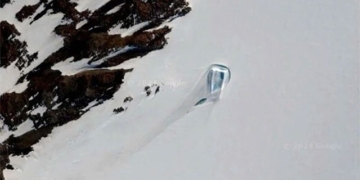Lalish is a village and temple complex in Kurdistan with a population of only 25. For the Yazidi people, this place is as sacred as Mecca is to Islam.
Located 125 kilometers northeast of Erbil (the capital of Kurdistan, an autonomous region in northern Iraq), the Lalish temple complex is village-sized and is the most sacred site for the Yazidi, an ancient religion with around 700,000 followers worldwide.
|
“Lalish is a sacred site for the Yazidi, just as Mecca is for Muslims or Jerusalem for followers of Islam, Christianity, and Judaism,” said Luqman Mahmood, the tourism relations leader. |
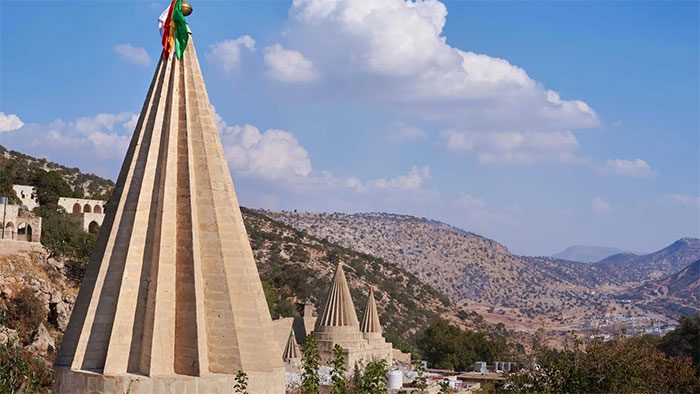
Lalish Temple.
This 4,000-year-old temple complex holds significant historical and religious importance. It is open not only to Yazidi followers but also welcomes those from other religions.
The site includes several temples, each characterized by distinctive conical towers with unique grooves. The most revered temple is the burial site of Sheikh Adi ibn Musafir, the founder of the faith.
The Yazidi faith is believed to have originated over 7,000 years ago. Over time, this ancient religion has gradually incorporated elements from other beliefs, including Zoroastrianism, Sufi Islam, Christianity, and Judaism.
The core belief of the Yazidi faith revolves around the existence of a single god, referred to as “Kuda” in the language of the Kurdish people. This supreme deity is considered the creator of humanity. According to Yazidi belief, all other living beings were created by a group of seven angels led by the Angel Malak Taus.
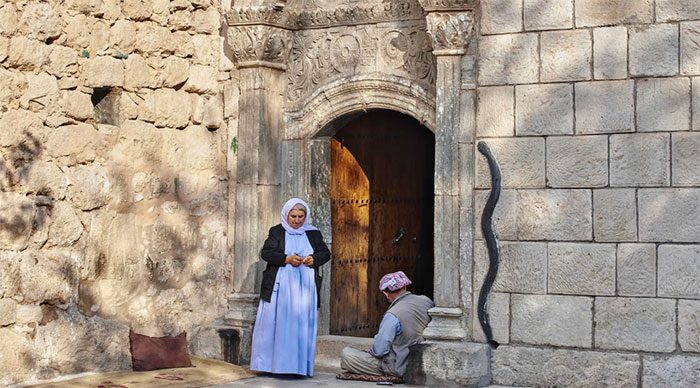
The snake is a special symbol and holds significant meaning for the Yazidi community.
Another important aspect of Yazidi faith is the special connection to the natural world. This is derived from ancient nature worship practices, emphasizing the deep relationship between humans and the environment. “The black snake at the entrance of the temple symbolizes our reverence for Mother Nature; we will never kill a snake, even if it is venomous,” Luqman Mahmood stated.
The snake is a significant symbol and holds deep meaning for the Yazidi community. According to their beliefs, the story of Noah’s Ark (Noah is a figure in religions that trace their origins to Abraham) has a different interpretation. When the ark came to rest on Mount Ararat after the 40-day and night flood, it began to leak and was at risk of sinking. At that moment, a snake used its own body to seal the leak, preventing the ark from sinking and saving everyone aboard.
Similar to how Muslims perform the Hajj pilgrimage to Mecca, the Yazidi also have a tradition of pilgrimage to Lalish at least once in their lifetime. Those living in Kurdistan or Iraq are encouraged to visit Lalish at least once a year.
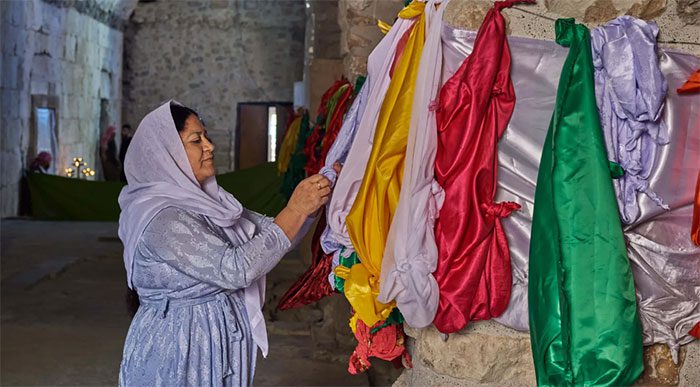
Tying girêk is a tradition involving tying knots with silk scarves hung around pillars and trees in the temple.
Pilgrims and visitors are required to enter the temple complex in modest attire and barefoot to show respect for the sacred space and the spiritual nature of the pilgrimage. They also participate in tying girêk, a tradition involving tying knots with silk scarves hung around the pillars and trees in the temple. Different colors represent the seven angels, while each knot symbolizes a prayer. The Yazidi believe that untangling a knot tied by someone else can help fulfill one’s wishes.
Only 25 people live in Lalish. They include priests, monks, nuns, and caretakers responsible for cleaning, maintaining, and caring for the fig, walnut, and olive trees around, as well as preparing the land for pilgrims.
Yazidi are encouraged to take soil from Lalish and carry it as a talisman. Soil also plays an important role in Yazidi funeral rites. The soil is mixed with holy spring water, and small clumps of this mixture are placed in the mouth, ears, and above the eyes of the deceased. Another custom is placing coins in the coffin, a practice dating back to ancient Babylon. This is intended to provide money for the deceased in the afterlife.
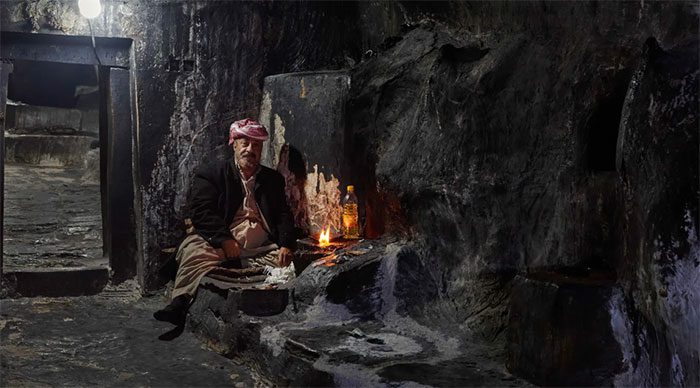
A caretaker burns long white strings in hopes of receiving donations for the sick, blessing the deceased, and bringing good fortune to the living.
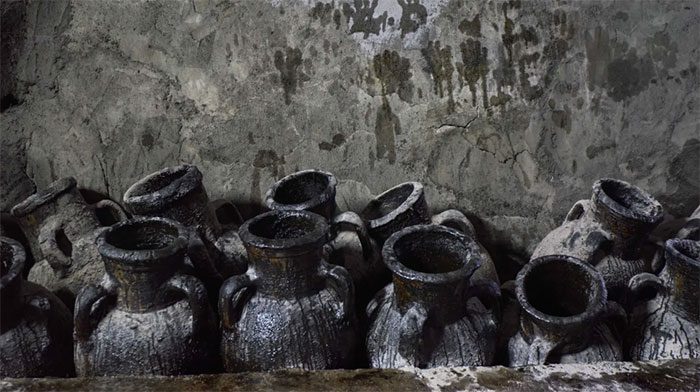
Olive oil is stored in clay jars and kept in the caves of the temple complex.
In the forests of Lalish, olives are harvested and then pressed by foot in wooden barrels. Olive oil is stored in clay jars and kept in the caves of the temple complex. This oil holds special significance in religious activities. The Yazidi pray toward the sun at least twice a day, at dawn and dusk. As night falls, 365 olive oil lamps are lit around the site. Each lamp represents a day of the year, symbolizing the light of the sun and of God. Light also plays a profound role even in the Yazidi conception of death. When a person passes away, they are buried facing the rising sun.
The Yazidi have faced numerous persecutions due to their differing beliefs, with instances dating back to Osman I, the founder of the Ottoman Empire. More than 70 instances of genocide have occurred since then, including actions taken by former President Saddam Hussein and members of the Islamic State. Yazidi men traditionally wore jamadani hats that were once white, but hats in Lalish are now adorned with red checkers to symbolize the bloodshed of the community. This traditional attire serves to honor those who have fallen and helps preserve their cultural heritage, reflecting the resilience of the Yazidi people in the face of adversity.
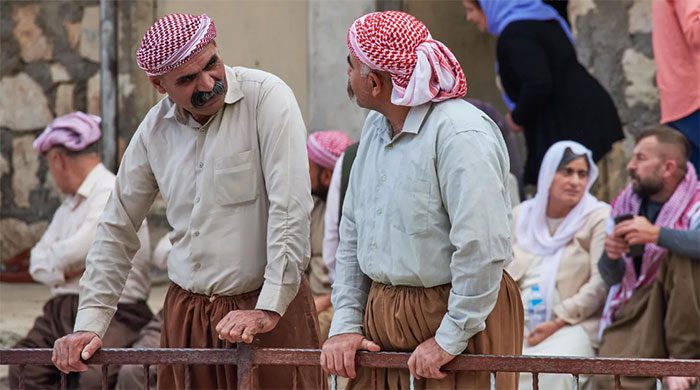
The jamadani hat in Lalish is now adorned with red checkers.
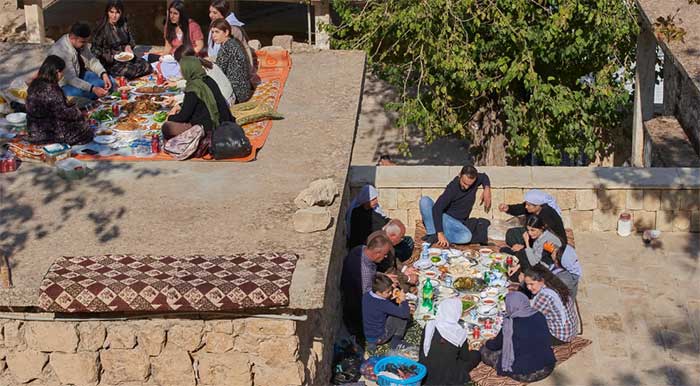
Sharing food plays an important role in fostering unity within the Yazidi community.
Friday is a sacred day for the Yazidi when community members gather in Lalish to pray and socialize. Edee Mahmood, the wife of Luqman Mahmood, emphasizes that sharing food plays a crucial role in promoting unity among them.
In an outdoor kitchen, Edee and other women prepare dishes from lamb and then share them with family, friends, and pilgrims from the Yazidi community outside. Although they express warm hospitality, Edee explains that the Yazidi do not see themselves as an inclusive community. This stems from their refusal to accept conversion or intermarriage with those of other beliefs.
She emphasizes that maintaining the purity of the Yazidi faith is essential for their way of life, providing a sense of inner peace and resilience to face any challenges. Just as a tree needs deep roots to stand firm, Edee compares this to the necessity of preserving the core values and beliefs of the Yazidi to maintain cultural identity and spiritual connection. “If the Yazidi are not influenced by external factors, we can maintain our way of life. That brings peace to our souls, and it means we have the ability to endure whatever happens to us. A tree without deep roots will soon fall. This is also true for the Yazidi.”















































